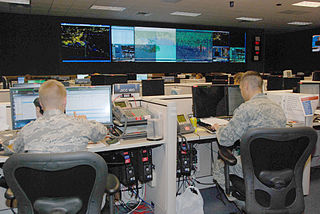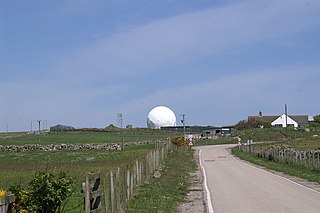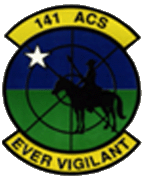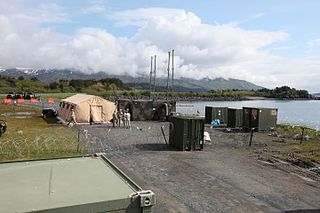
The NATO Integrated Air Defense System is a command and control network combining radars and other facilities spread throughout the NATO alliance's air defence forces. It formed in the mid-1950s and became operational in 1962 as NADGE. It has been constantly upgraded since its formation, notably with the integration of Airborne Early Warning aircraft in the 1970s. The United Kingdom maintained its own network, but was fully integrated with the network since the introduction of the Linesman/Mediator network in the 1970s. Similarly, the German network maintained an independent nature through GEADGE.

The French Air and Space Force is the air and space force of the French Armed Forces. Formed in 1909 as the Service Aéronautique, a service arm of the French Army, it became an independent military branch in 1934 as the French Air Force. On 10 September 2020, it assumed its current name, the French Air and Space Force, to reflect an "evolution of its mission" into the area of outer space.

Royal Air Force Boulmer or more simply RAF Boulmer is a Royal Air Force station near Alnwick in Northumberland, England, and is home to Aerospace Surveillance and Control System (ASACS) Force Command, Control and Reporting Centre (CRC) Boulmer.
Air Command and Control System (ACCS) is the NATO project planned to replace the NATO Air Command and Control Systems of the 1990s. At the highest level it comprised the Combined Air Operations Centre (CAOC) from which the air battle is run. Beneath this level of command is the Air Control Centre (ACC), Recognized Air Picture (RAP) Production Centre (RPC) and Sensor Fusion Post (SFP) combined in one entity called ARS. The ARS is the equivalent to the Control and Reporting Centers (CRCs) operated in the 1990s. The ACCS project comprised both static and deployable elements. Under separate funding, NATO intended to procure deployable sensors for the deployable ACCS component (DAC).

Baltic Air Surveillance Network (BALTNET) is an air defense radar network operated by the Baltic States of Latvia, Lithuania and Estonia.

Marine Air Control Group 28 (MACG-28) is a United States Marine Corps aviation command and control unit based at Marine Corps Air Station Cherry Point that is currently composed of four command and control squadrons and a low altitude air defense battalion that provide the 2nd Marine Aircraft Wing with airspace coordination, air control, immediate air support, fires integration, air traffic control (ATC), radar surveillance, aviation combat element (ACE) communications support, and an integrated ACE command post in support of the II Marine Expeditionary Force.

The Baltic air-policing mission is a NATO air defence Quick Reaction Alert (QRA) in order to guard the airspace above the three Baltic countries of Estonia, Latvia and Lithuania.

Command and control is a "set of organizational and technical attributes and processes ... [that] employs human, physical, and information resources to solve problems and accomplish missions" to achieve the goals of an organization or enterprise, according to a 2015 definition by military scientists Marius Vassiliou, David S. Alberts, and Jonathan R. Agre. The term often refers to a military system.

The Estonian Air Force is the aviation branch of the Estonian Defence Forces. The air force traces its history to 1918, and was re-established in its current form in 1991.

An Air Operations Center (AOC) is a type of command center used by the United States Air Force (USAF). It is the senior agency of the Air Force component commander to provide command and control of air operations.

The Allied Air Command (AIRCOM) is the central command of all NATO air and space forces and the Commander Allied Air Command is the prime air and space advisor to the Alliance. When directed by the Supreme Allied Commander Europe (SACEUR), it provides the core of the headquarters responsible for the conduct of air operations. The command is based at the Ramstein Air Base in Germany.
The French air defence organisation is integrated in the military Armée de l’Air (ALA), the French Air Force.

Remote Radar Head Buchan or RRH Buchan is an air defence radar station operated by the Royal Air Force. It is located at Stirling Hill, 3.2 kilometres (2.0 mi) south of Peterhead on the Aberdeenshire coast of North East Scotland.

Quick Reaction Alert (QRA) is state of readiness and modus operandi of air defence maintained at all hours of the day by NATO air forces. The United States usually refers to Quick Reaction Alert as 'Airspace Control Alert'.

The 141st Air Control Squadron (ACS) is a unit of the Puerto Rico Air National Guard. It is a mobile radar command, control and communications element of the United States Air Force Theater Air Control System located at Punta Borinquen Radar Station near by Rafael Hernandez Airport formerly Ramey Air Force Base in Aguadilla, Puerto Rico.
An air tasking order (ATO) is a means by which the Joint Forces Air Component Commander (JFACC) controls air forces within a joint operations environment. The ATO is a large document written in United States Message Text Format (USMTF) that lists air sorties for a fixed 24-hour period, with individual call signs, aircraft types, and mission types. NATO uses a different text format, “.ato”. The ATO is created by an Air Operations Center (AOC) which has command and control for a particular theater. More specifically, the Combat Plans Division of the AOC is responsible for creating the ATO, as well as the associated Airspace Control Order (ACO) and linked detailed information in the Special Instructions (SPINS).
Link 1 is a computer network standard developed by NATO to provide information exchange for air defence.
Combined Air Operations Centre Finderup was located on the Jutland peninsula, approximately 20 km west of Viborg in the middle of the Finderup military training area in Denmark. It was part of NATO's Air Policing mission and was responsible of the airspace around Iceland, Norway, Denmark and the United Kingdom. Under the NATO Integrated Air Defence System (NATINADS) concept, resources are allocated by nations to NATO for the purpose of Air Defence in peacetime. At the end of June 2013 the CAOC was deactivated and responsibility for its Air Policing Area was passed to Combined Air Operations Centre Uedem in Germany under the new NATO Force Structure.

Combined Air Operations Centres (CAOCs) are multinational headquarters for tactical and operational control of NATO Air Forces below the Joint Force Command level. They operate within the NATO Integrated Air Defense System (NATINADS) framework.

The Tactical Air Operations Center (TAOC) is the principal air defense agency of the United States Marine Corps' Marine Air Ground Task Force (MAGTF). The TAOC provides real time aerial surveillance of assigned airspace, and its personnel identify, and control the intercept of hostile aircraft and missiles. It also directs and controls all Surface-to-air missiles in the MAGTF's area of operations.
















